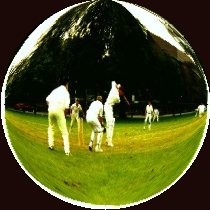The odd name of the popping crease refers to the early history of the game of cricket, in that batsmen used to have to 'pop' their bats into a small hole that was located in the middle of the crease for a run to count. For a player to run a batsman out he had to pop the ball into the hole before the bat was grounded in it.
One popping crease is drawn at each end of the pitch in front of each of the two sets of stumps. The popping crease must be 4 feet (1.22 m) in front of and parallel to the bowling crease. Although it is considered to have unlimited length, the popping crease must be marked to at least 6 feet (1.83 metres) on either side of the imaginary line joining the centres of the middle stumps.
The popping crease is used in one test of whether the bowler has bowled a no ball. To avoid a no ball, some part of the bowler's front foot in the delivery stride (that is, the stride when he releases the ball) must be behind the popping crease (although the bowler's front foot does not have to be grounded).
 Popping crease
Popping creaseIn addition, the popping crease determines whether a batsman has been stumped or run out. This is described in Laws 29, 38, and 39 of the Laws of cricket.
If the batsman facing the bowler (the striker) steps in front of the popping crease to play the ball, leaving no part of his anatomy or the bat on the ground behind the crease, and the wicket-keeper (in possession of the ball) is able to remove the bails from the wicket, then the striker is out stumped.
If a fielder uses the ball to remove the bails from either set of stumps whilst the batsmen are running between the wickets (or otherwise forward of the popping crease during the course of play), then the batsman (striker or non-striker) is out run out. Return crease
The batting crease is nothing but the popping crease on the other side of the pitch with respect to the bowler. It is the crease where the batsman stands while batting.
No comments:
Post a Comment